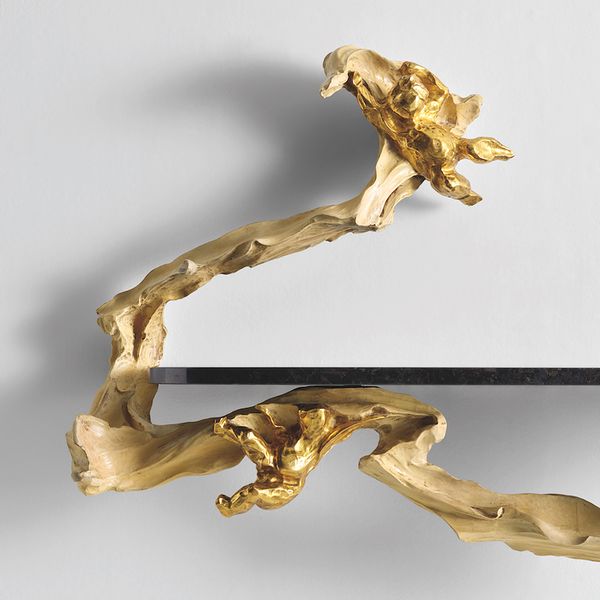Lucio Fontana and Osvaldo Borsani, Wall-mounted console, designed for the dining room of Casa S., Milan, c. 1950. Estimate £100,000 - 150,000. Design London.
Exploring the relationship between the object and space, this remarkable wall-mounted console is the result of the collaboration and friendship of artist Lucio Fontana and architect Osvaldo Borsani. Synthesising classical and modern vocabularies, the work dates from the early 1950s and belongs to a series of furniture and interiors designed by Borsani that incorporate painted or sculptural elements by Fontana. Borsani’s work was expanding from the highly customised artisan production of Arredamenti Borsani Varedo towards the industrial design of Tecno, coinciding with the transition in Fontana’s work from his Baroque-inspired forms to Spatialism.

Lucio Fontana and Osvaldo Borsani, Wall-mounted console, designed for the dining room of Casa S., Milan (detail), c. 1950. Estimate £100,000 - 150,000. Design London.
Throughout the 1950s, Borsani and Fontana collaborated on residential and commercial projects, through which they developed ideas that explored extending surfaces and spaces. While referencing Baroque ceiling frescoes, the console’s sculptural extension from the wall also parallels Fontana’s investigation into dissolving its physical dimension, reflecting his and Borsani’s shared desire to address conventional relationships between the object and its surrounding space. Fontana had published his first manifesto on Spatialism in 1947 in which he called for a synthesis in art of color, sound, movement and time, leading to the development of his "spatial environments." Fontana’s collaborative work with architects such as Borsani, who also offered an additional set of technical skills, provided an important avenue for his exploration of space and the integration of art and the viewer within it.
The [a]esthetic of the organic movement replaces the empty [a]esthetic of fixed forms. – Lucio Fontana
Having embraced new ideological and technological advances throughout his career, Borsani played an instrumental role in the formation of Italian modernist design, while remaining dedicated to the country’s tradition of craftsmanship and quality of materials. This enduring commitment paired with his pursuit and understanding of design as addressing more than the functional underscored Borsani’s collaborative approach to his work. With a desire to bring art into the everyday environment, Borsani fostered a dialogue within his practice that extended beyond the traditional bounds of architecture and design.
Where the plastic form is inseparable from the notion of time, the images appear to abandon the plane and continue into space the movements they suggest. – Lucio Fontana
This interdisciplinary approach flourished in the context of post-war Milan and the resulting economic upturn, which created a momentum and openness for an exchange of ideas and research across cultural fields. Fontana’s spatial research and exploration of dimensionality provided an intersection for artistic exchange between the artist and Borsani, which expanded the expressive possibilities of both their practices.

Lucio Fontana and Osvaldo Borsani, Wall-mounted console, designed for the dining room of Casa S., Milan (detail), c. 1950. Estimate £100,000 - 150,000. Design London.
Each element of Borsani’s interiors were considered within the entire composition, often achieved through a dialogue between tradition and innovation, to create a continuity of material and space. The asymmetry and surface effect of the black marble tabletop with highlights of blue and silver creates a dynamic quality that moves beyond the Rationalist design of Borsani’s earlier work, while retaining a purity of form. The sculptural supporting frame executed to Fontana’s design and handpainted by the artist, further contributes to this freer approach. The iconography of the gilded putti, which give the illusion of supporting the painted veil surrounding the marble slab, and reference Italian Renaissance and Baroque art, suggest movement as they lift the console through space. The work appears expressive and free of constraint, while simultaneously structuring the composition of the original interior, together reflecting the dynamic exchange between architect and artist.
Discover More from Design London >

Recommended Reading
Gio Ponti's Surprising Predecessor >
One Artist You Need to Know: Beverly Pepper >
